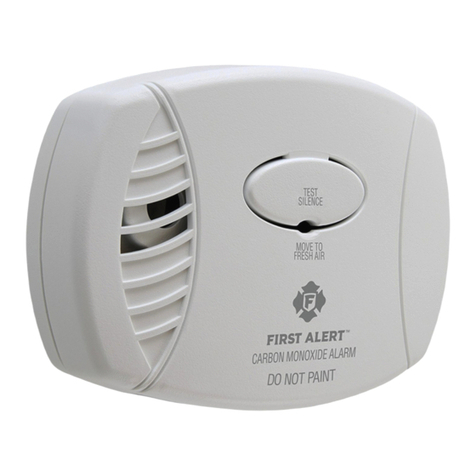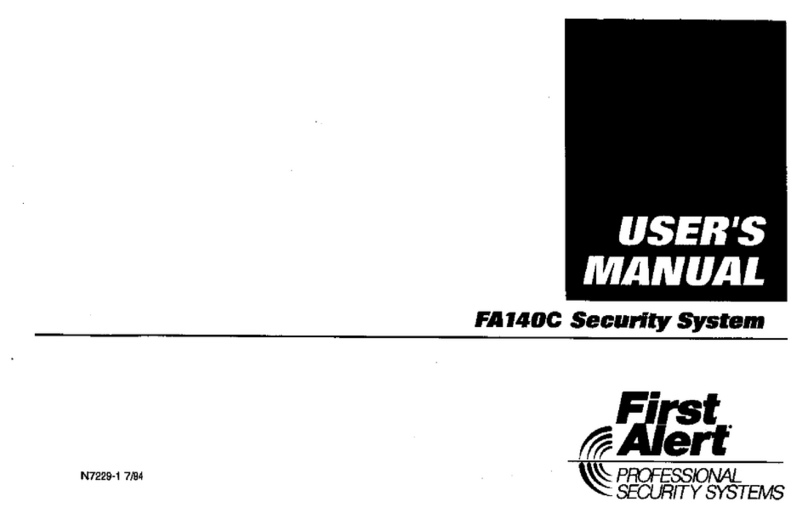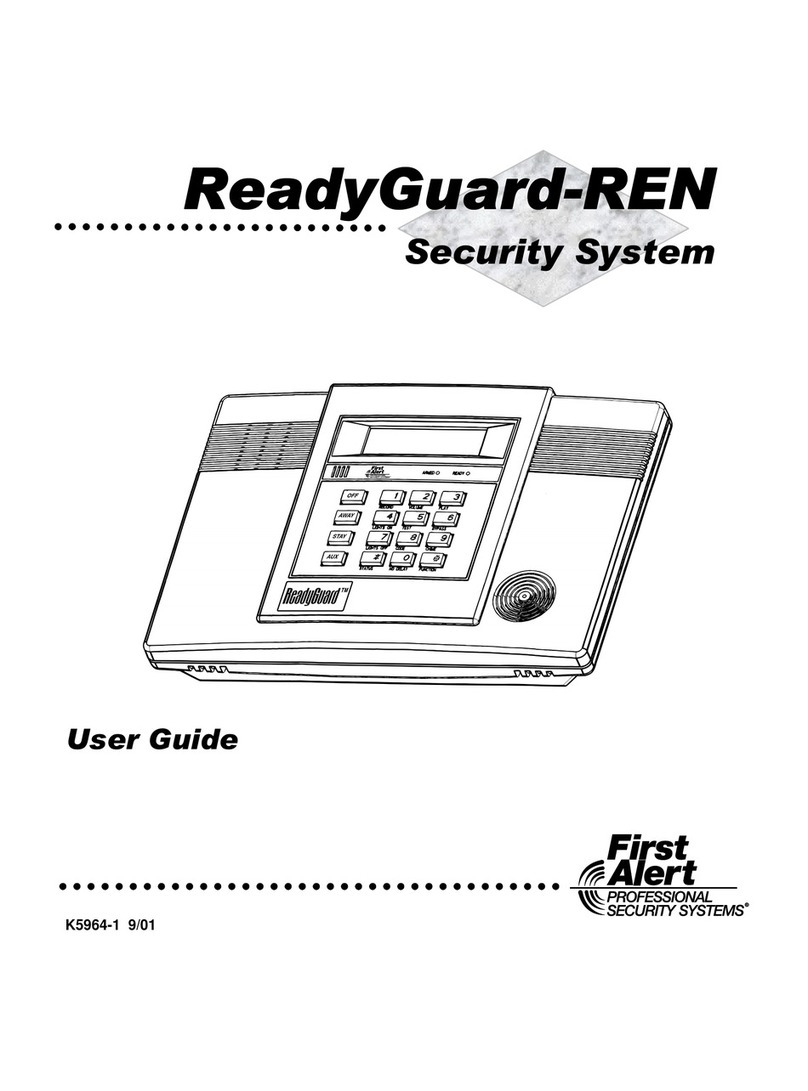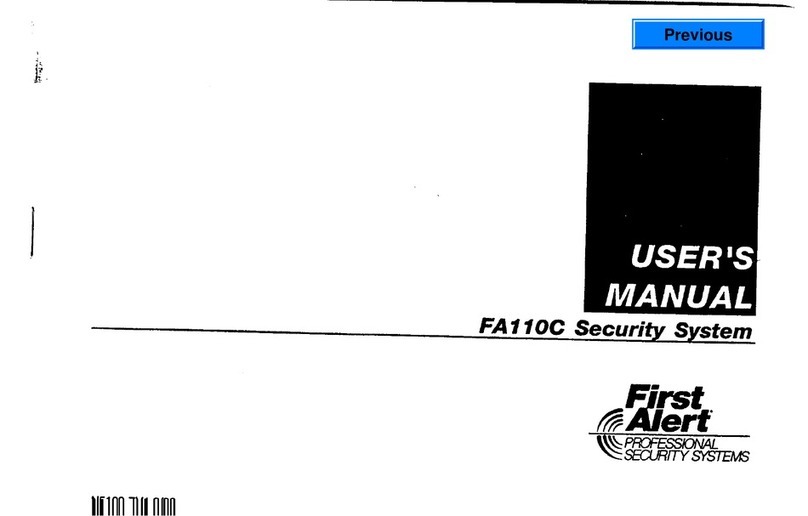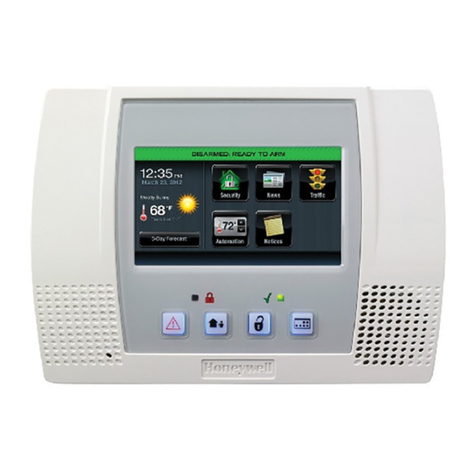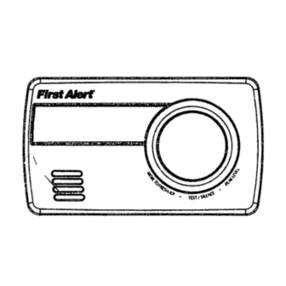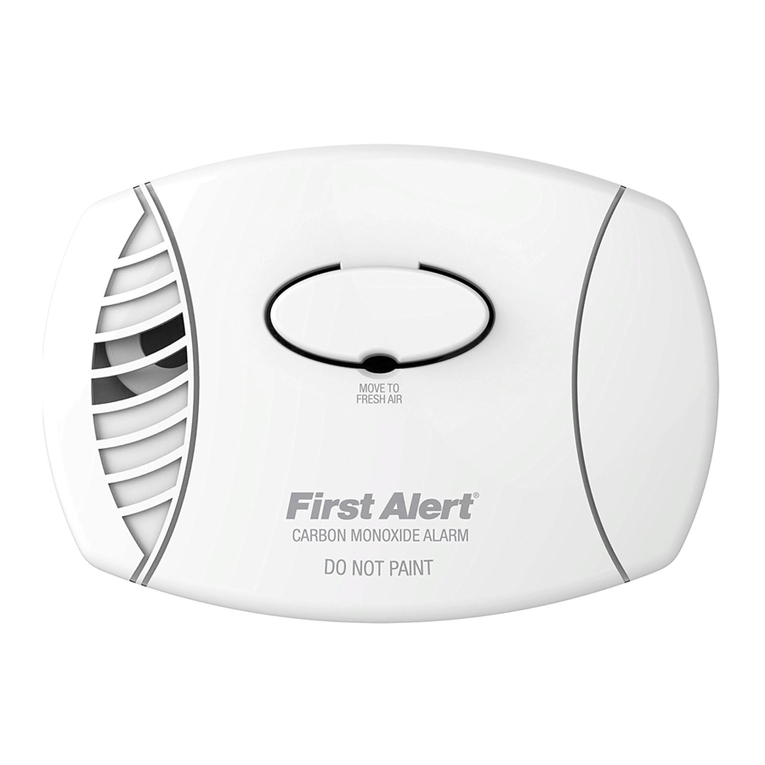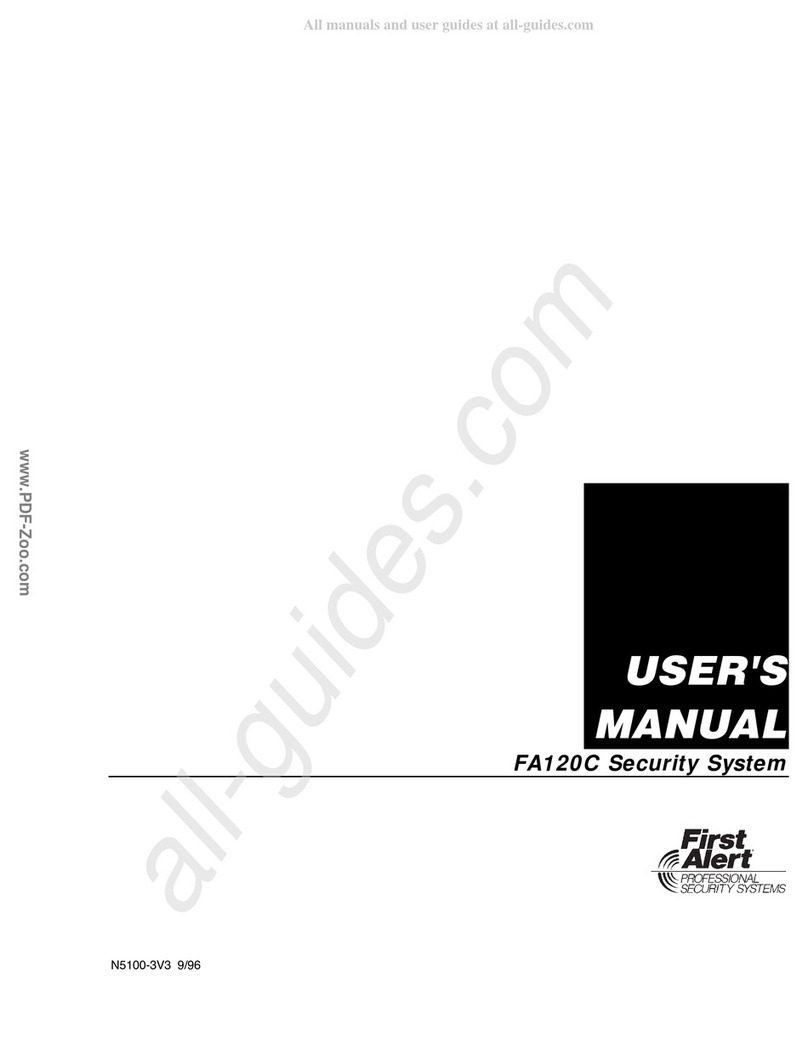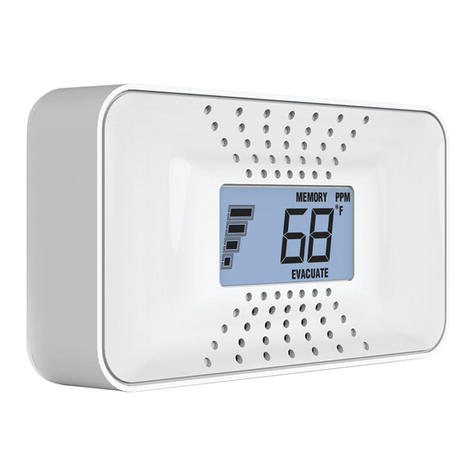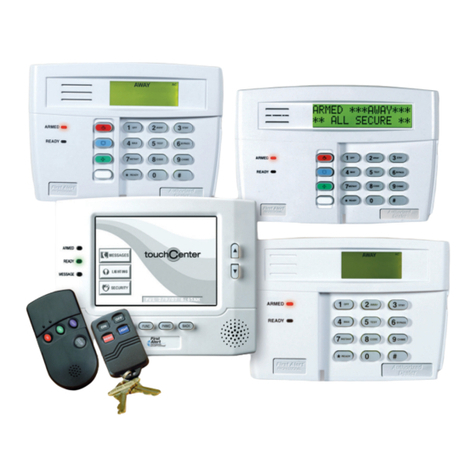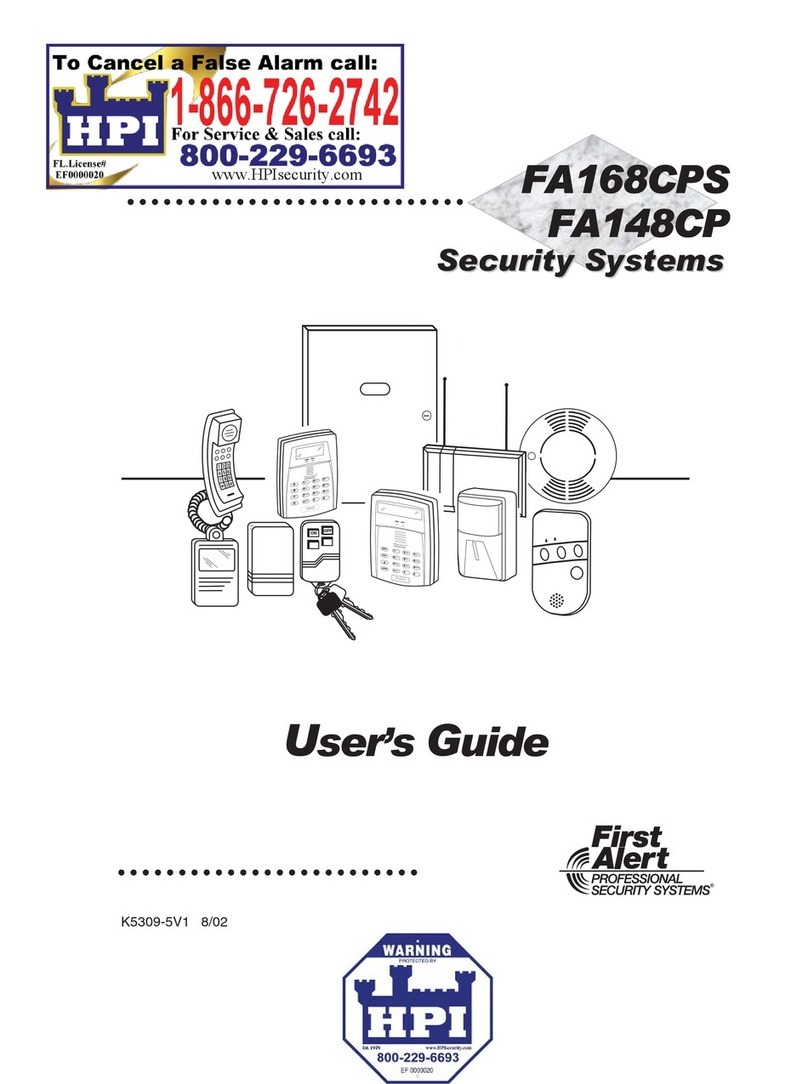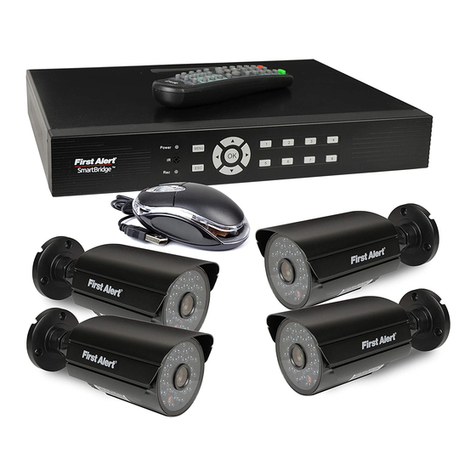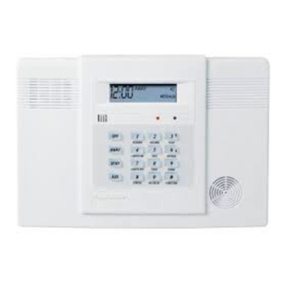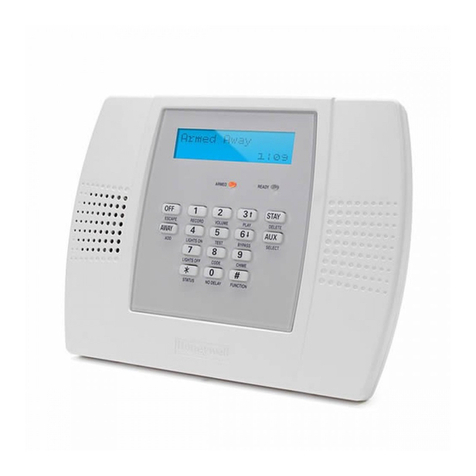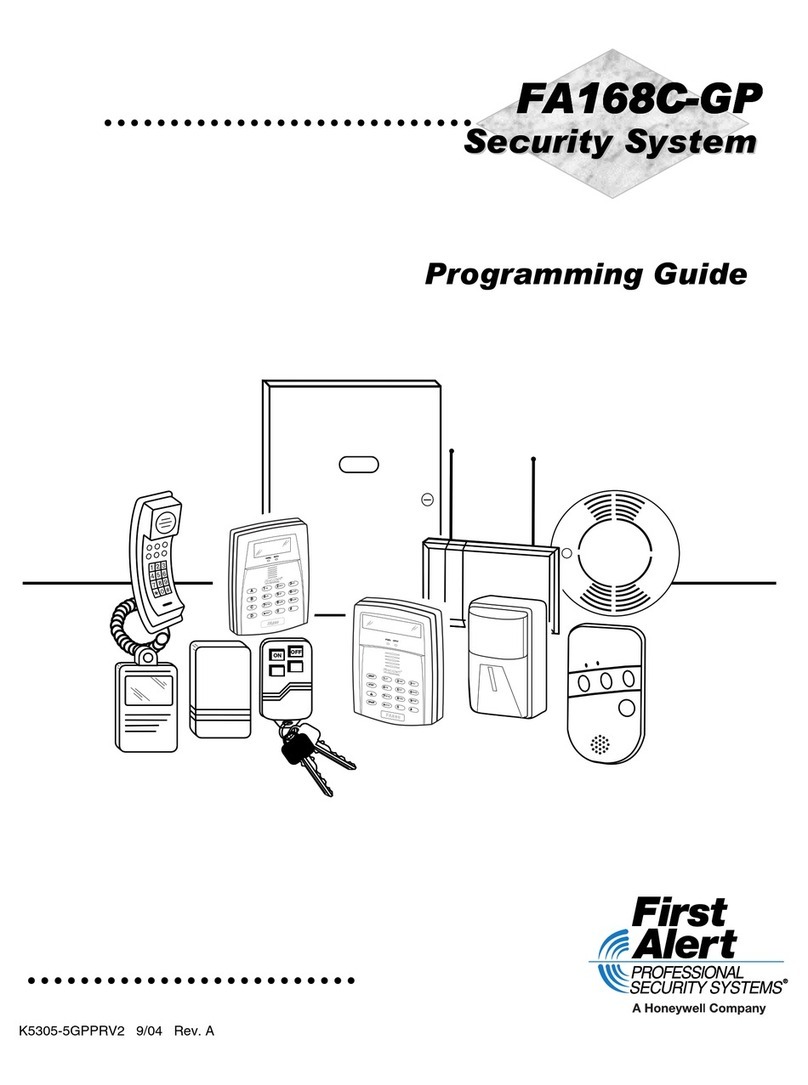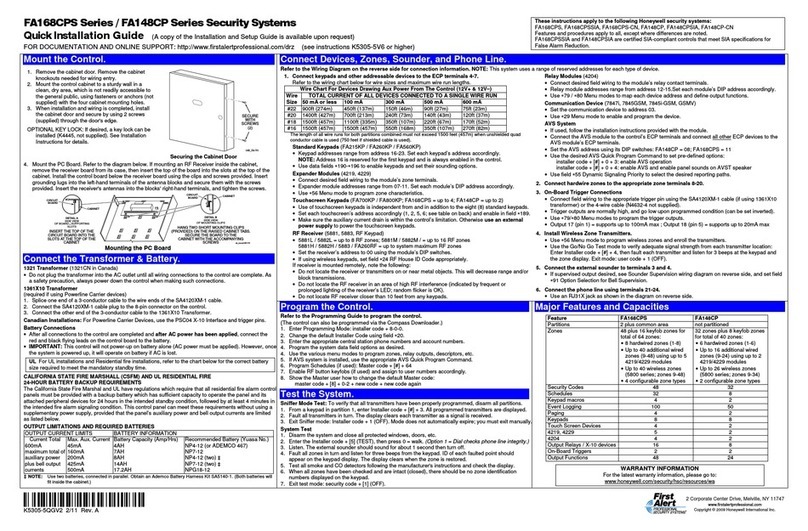
3.875 inches
3.875 inches
Mounting Guide Template
3 7/8 inches (98mm)
WHAT TO DO IF EXPLOSIVE GAS IS DETECTED
If you hear the alarm horn sound one beep per second, gas has been detected.
The word GAS will be displayed. Evacuate everyone from the building.
1. Leave the house immediately, opening doors and windows as you leave.
2. Do not use your telephone or appliances. Do not turn any light
switches off or on. Any spark or flame could ignite the gas.
3. Call 911 and your gas company from a phone that is away from your home.
4. Do not re-enter the area until the source of the leak is found and corrected.
• If the unit alarms and you are not testing the unit, it is warning you of a
potentially dangerous situation that requires your immediate attention. NEVER
ignore any alarm. Ignoring the alarm may result in injury or death.
• Never disconnect the power to quiet an unwanted alarm. Disconnecting
the power disables the Alarm. This will remove your protection.
Alarms have various limitations. See “General Limitations of Explosive Gas/CO Alarms” for
details.
IF THE CO ALARM SOUNDS:
1. Operate the Test/Silence button.
2. Call your emergency services, fire department or 911. Write down the number of your local
emergency service here:
_______________________________________________________________
3. Immediately move to fresh air—outdoors or by an open door or window. Do a head count
to check that all persons are accounted for. Do not re-enter the premises, or move away
from the open door or window until the emergency services responder has arrived, the
premises have been aired out, and your CO Alarm remains in its normal condition.
4. After following steps 1-3, if your CO Alarm reactivates within a 24-hour period, repeat steps
1-3 and call a qualified appliance technician to investigate for sources of CO from fuel-burning
equipment and appliances, and inspect for proper operation of this equipment. If problems are
identified during this inspection have the equipment serviced immediately. Note any combustion
equipment not inspected by the technician, and consult the manufacturers’ instructions, or
contact the manufacturers directly, for more information about CO safety and this equipment.
Make sure that motor vehicles are not, and have not, been operating in an attached garage or
adjacent to the residence. Write down the number of a qualified appliance technician here:
_______________________________________________________________
IF YOUR GAS/CO ALARM SOUNDS
WHAT TO DO IF CARBON MONOXIDE IS DETECTED
Actuation of your CO Alarm indicates the presence of carbon monoxide (CO) which can kill you. In
other words, when your CO Alarm sounds, you must not ignore it!
USING THE SILENCE FEATURES
N
EVER disconnect the power to your Alarm to silence the horn—use the Silence Feature.
Disconnecting the Alarm removes your protection!
• The Silence Feature is intended to temporarily silence the horn
while you identify and correct the problem.
• To use the Silence Feature, press the Test/Silence button until the horn is silent.
• If the Test/Silence button is pressed while the Alarm is in the
silence mode, the alarm will start sounding again.
When the GAS Alarm is silenced...
The Alarm will remain silent for approximately 2 minutes and then return to normal operation.
If the gas has not cleared within the silence period, the unit will go back into alarm.
When the CO Alarm is silenced...
The CO Alarm will remain silent for up to 4 minutes. While the Alarm is
silenced, it will continue to monitor the air for CO. After 4 minutes, if CO levels
remain potentially dangerous the horn will start sounding again.
The Silence Feature is intended to temporarily silence the Alarm horn. It will not correct a CO or gas problem.
SILENCING THE LOW BATTERY WARNING
This Silence Feature can temporarily quiet the low battery warning “chirp” for up to 8 hours if AC
power is present. You can silence the low battery warning “chirp” by pressing the Test/Silence
button on the Alarm cover until you see the Green LED flicker, acknowledging the button-press.
The display will flash “SILENCE” for 8 hours while the low battery warning “chirp”
silence feature is activated. After 8 hours, the low battery “chirp” will resume. The
Alarm will continue to operate as long as AC power is supplied. However, replace the
battery as soon as possible, to maintain protection in event of a power outage.
USING THE PEAK CO MEMORY
The CO Memory Feature lets you check the highest level of CO recorded.
To check CO Memory:
1. Press the Display button until the peak CO level is displayed.
To clear CO Memory:
1. Automatically resets after 24 hours.
2. a. While checking CO memory, press or hold the Display button until
“CLEAR” is displayed.
b. Press or hold the Display button until the CO Memory is cleared.
3. Remove all power; unplug the Alarm and remove the battery.
NOTE: The highest CO level will be saved for 24 hours. DO NOT clear the CO Memory reading
if you plan to call someone to investigate a CO problem! Clear the CO Memory reading only
after the investigator has checked your home. If the investigator will not arrive within the 24
hour time period before the unit automatically resets, be sure to write down the peak level.
SILENCING THE END OF LIFE SIGNAL
This silence feature can temporarily quiet the End of Life warning “chirp” for up to 2 days.
You can silence the End of Life warning “chirp” by pressing the Test/Silence button. The
horn will chirp, acknowledging that the End of Life silence feature has been activated.
After approximately 2 days, the End of Life “chirp” will resume.
UNDERSTANDING THE LIGHT, HORN, AND DISPLAY PATTERNS
Condition LED Horn Display
NORMAL AC POWER LED is Green Silent All segments of display are turned on for a
short time upon initial power. Then the battery
level icon is displayed.
BATTERY BACK-UP
POWER
LED is Off, flashing Green
once every 45 seconds
Silent All segments of display are turned On for
a short time upon initial power. Then the
battery level icon is displayed flashing.
DURING TESTING LED flashes Red in sync
with the horn, simulating an
Alarm condition: first gas
then CO
First, the horn pattern for gas
alarm (1 beep every second) is
issued, and then the CO alarm
horn pattern (4 beeps, pause,
4 beeps) is issued.
During the simulated gas alarm, “GAS” is
displayed along with a full alarm level.
During the simulated CO alarm, “CO” is
displayed along with a full alarm level.
Several ppm CO levels are also displayed and
the alarm level is shown increasing.
LOW OR MISSING
BATTERY
Normal A chirp is issued about every
minute.
Battery icon will show either 1 bar or an
empty icon.
GAS ALARM
CONDITION
LED flashes Red in sync with
horn
Repeating 1 beep every
second
“GAS”, a full level, and “EVACUATE”
CARBON MONOXIDE
ALARM
LED flashes Red in sync
with horn
Repeating
4 beeps, pause
“CO” alternating with the ppm number, a full
level, and “EVACUATE”.
PRE-ALARM
CONDITION
CO IS PRESENT
Normal Normal
“CO” alternating with the ppm number. The level
will indicate relative CO exposure level.
MALFUNCTION LED flashing Green 3 times
in sync with 3 chirps
3 chirps every minute “Err” is displayed.
LOW BATTERY
SILENCE
LED is Green Silent “bat” and “SILENCE” are displayed.
END OF LIFE LED flashing Green 5 times
in sync with 5 chirps
5 chirps every minute “End” is displayed.
REGULAR MAINTENANCE
This unit has been designed to be as maintenance-free as possible, but there
are a few simple things you must do to keep it working properly:
• Test it at least once a week.
• Clean the Alarm at least once a month; gently vacuum the outside of the Alarm
using your household vacuum’s soft brush attachment. Test the Alarm. Never
use water, cleaners or solvents since they may damage the unit.
• Relocate the unit if it sounds frequent unwanted alarms. See
“Where This Alarm Should Not Be Installed” for details.
• When the battery back-up becomes weak, the Alarm will “chirp” about once a minute (the low
battery warning). You should replace the battery immediately to continue your protection.
This Alarm must have AC or battery power to operate. If AC power fails,
and the battery is dead or missing, the Alarm cannot operate.
DO NOT spray cleaning chemicals or insect sprays directly on or near the Alarm. DO NOT paint
over the Alarm. Doing so may permanently damage the Alarm.
CHOOSING A REPLACEMENT BATTERY:
Your Alarm requires one standard 9V alkaline battery. The following batteries
are acceptable as replacements: Duracell #MN1604, (Ultra) #MX1604; Eveready
(Energizer) #522. These batteries are available at many local retail stores.
• Always use the exact batteries specified by this User’s Manual. DO NOT use
rechargeable batteries. Clean the battery contacts and also those of the device prior
to battery installation. Install batteries correctly with regard to polarity (+ and -).
• Please dispose of or recycle used batteries properly, following any local
regulations. Consult your local waste management authority or recycling
organization to find an electronics recycling facility in your area. DO NOT
DISPOSE OF BATTERIES IN FIRE. BATTERIES MAY EXPLODE OR LEAK.
• Keep battery out of reach of children. In the event a battery is swallowed,
immediately contact your poison control center, your physician, or the
National Battery Ingestion hotline as serious injury may occur.
Actual battery service life depends on the Alarm and the environment in which it is installed. All the
batteries specified above are acceptable replacement batteries for this unit. Regardless of the
manufacturer’s suggested battery life, you MUST replace the battery immediately once the unit starts
“chirping” (the “low battery warning”).
WHAT YOU NEED TO KNOW ABOUT CO
WHAT IS CO?
CO is an invisible, odorless, tasteless gas produced when fossil fuels do not burn completely,
or are exposed to heat (usually fire). Electrical appliances typically do not produce CO.
These fuels include: Wood, coal, charcoal, oil, natural gas, gasoline, kerosene,
and propane.
Common appliances are often sources of CO. If they are not properly maintained,
are improperly ventilated, or malfunction, CO levels can rise quickly. CO is a real
danger now that homes are more energy efficient. “Air-tight” homes with added
insulation, sealed windows, and other weatherproofing can “trap” CO inside.
SYMPTOMS OF CO POISONING
These symptoms are related to CO POISONING and should
be discussed with ALL household members.
Mild Exposure: Slight headache, nausea, vomiting, fatigue (“flu-like” symptoms).
Medium Exposure: Throbbing headache, drowsiness, confusion, fast heart rate.
Extreme Exposure: Convulsions, unconsciousness, heart and lung failure.
Exposure to Carbon Monoxide can cause brain damage, death.
Some individuals are more sensitive to CO than others, including people with cardiac or
respiratory problems, infants, unborn babies, pregnant mothers, or elderly people can be
more quickly and severely affected by CO. Members of sensitive populations should consult
their doctors for advice on taking additional precautions.
FINDING THE SOURCE OF CO AFTER AN ALARM
Carbon monoxide is an odorless, invisible gas, which often makes it difficult to locate the source of
CO after an alarm. These are a few of the factors that can make it difficult to locate sources of CO:
• House well ventilated before the investigator arrives.
• Problem caused by “backdrafting.”
• Transient CO problem caused by special circumstances.
Because CO may dissipate by the time an investigator arrives, it may be
difficult to locate the source of CO. BRK Brands, Inc. shall not be obligated
to pay for any carbon monoxide investigation or service call.

